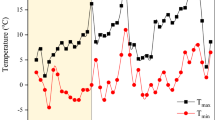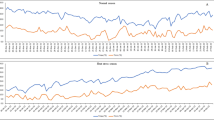Summary
The genotypic variation for heat tolerance in chickpea, groundnut, pigeonpea, and soya bean was evaluated by testing membrane stability and photosystem (PSII) function in leaves at high temperatures. The legumes could be ranked from heat-tolerant to sensitive in the order: groundnut, soya bean, pigeonpea and chickpea. The damage to cell membranes (as reflected by an increased leakage of electrolytes) and PS II (as reflected by a decrease in the ratio of variable to maximum fluorescence) was less, and recovery from heat stress was faster in groundnut than in other crops. Prior exposure of plants to 35°C for 24h led to a reduced leakage of electrolytes at high temperatures in all crops but the differences among legumes were consistent. Substantial genotypic variation for heat tolerance was found in all legumes. Membrane injury was negatively associated with specific leaf weight in groundnut (r=−0.69**) and soya bean (r=−0.56**) but not in the pulses. Electrolyte leakage and fluorescence ratio were negatively correlated in all legumes. The potential use of electrolyte leakage and fluorescence tests as screening procedures for breeding heat-tolerant legumes is discussed.
Similar content being viewed by others
Abbreviations
- RI:
-
relative injury
- Fo:
-
initial fluorescence
- Fm:
-
maximum fluorescence
- Fv:
-
variable fluorescence
- PS II:
-
photosystem II
- PAR:
-
photosynthetically active radiation
References
Alexandrov, V.Y., 1964. Cytophysiological and cytoecological investigations of heat resistance of plant cells toward the action of high and low temperature. Quart. Rev. Biol. 39: 35–77.
Baker, N.R., M. Bradbury, P.K. Farage, C.R. Ireland & S.P. Long, 1989. Measurements of quantum yield of carbon assimilation and chlorophyll fluorescence for assessment of photosynthetic performance of crops in the field. Phil. Trans. R. Soc. London B. 323: 295–308.
Bar-Tsur, A., J. Rudich & B. Barvdo, 1985. High temperature effects on CO2 gas exchange in heat tolerant and sensitive tomatoes. J. Am. Soc. Hort. Sci. 110: 582–586.
Bernstam, V.A., 1978. Heat effects on protein biosynthesis. Annu. Rev. Plant Physiol. 29: 25–46.
Blum, A., 1988. Plant breeding for stress environments. CRC Press Inc., Boca Raton, Florida.
Brown, D.M., 1960. Soya bean ecology. I. Development temperature relationships from controlled environment studies. Agron. J. 52: 493–496.
Demmig, B. & O. Bjorkman, 1987. Comparison of the effect of excessive light on chlorophyll fluorescence (77K) and photon yield of O2 evolution of leaves of higher plants. Planta 171: 171–184.
Demmig, B., K. Winter, A. Kruger & F.C. Czygan, 1987. Photoinhibition and zeaxanthin formation in intact leaves. A possible role of the xanthophyll cycle in the dissipation of excess light energy. Plant Physiol. 84: 218–224.
Hall, A.E., 1992. Breeding for heat tolerance. Plant Breeding Rev. 10: 129–168.
IRRI, 1992. IRRISTAT User's Manual. Biometrics Unit, International Rice Research Institute, Manila, Philippines, 122 pp.
Jarvis, M.C., W. Forsyth & H.J. Duncan, 1988. A survey of the pectin content of nonlignified monocot cell walls. Plant Physiol. 88: 309–314.
Ketring, D.L., 1984. Temperature effects on vegetative and reproductive development of peanut. Crop Sci. 24: 877–882.
Krause, G.H. & E. Weiss, 1984. Chlorophyll fluorescence as a tool in plant physiology. II. Interpretation of fluorescence signals. Photosyn. Res. 5: 139–157.
Kuo, C.G., H.M. Chen & H.C. Sun, 1993. Membrane thermostability and heat tolerance of vegetable leaves. In: C.G. Kuo (Ed.). Adaptation of Food Crops to Temperature and Water Stress. Asian Vegetable Research and Development Center, Shanhua, Taiwan. pp. 160–168.
Levitt, J., 1980. Responses of plants to environmental stresses. Vol. I. Chilling, freezing and high temperature stresses. Academic Press, New York, USA.
Lin, C.Y., Y.M. Chen & J.L. Key, 1985. Solute leakage in soya bean seedlings under various heat shock regimes. Plant Cell Physiol. 26: 1493–1498.
MacRae, E.A., A.K. Hardacre & I.B. Ferguson, 1986. Comparison of chlorophyll fluorescence with several other techniques used to assess chilling sensitivity in plants. Physiol. Plant. 67: 659–665.
Malhotra, R.S. & M.C. Saxena, 1993. Screening for cold and heat tolerance in cool-season food legumes. In: K.B. Singh & M.C. Saxena (Eds). Breeding for stress tolerance in cool season food legumes. John Wiley & Sons, Chichester, UK. pp. 227–244.
Martineau, J.R., J.E. Specht, J.H. Williams & C.Y. Sullivan, 1979. Temperature tolerance in soybeans. I. Evaluation of a technique for assessing cellular membrane thermostability. Crop Sci. 19: 75–78.
Moffat, J.M., R.G. Sears & G.M. Paulsen, 1990. Wheat high temperature tolerance during reproductive growth. II. Genetic analysis of chlorophyll fluorescence. Crop Sci. 30: 886–889.
Potvin, C., 1985. Effect of leaf detachment on chlorophyll fluorescence during chilling experiments. Plant Physiol. 78: 883–886.
Quinn, P.J., 1989. Membrane stability under thermal stress. In: P.A. Biacs, K. Gruiz & K. Kremmer (Eds). Biological role of lipids. Plenum Publ. New York, USA, pp. 511–515.
Sandalla, M.M., J.F. Shanahan & J.S. Quick, 1990. Heat tolerance in winter wheat. I. Hardening and genetic effects on membrane thermostability. Crop Sci. 30: 1243–1247.
Sapca, V.T. & A.O. Anaele, 1991. Screening soybean genotypes for drought and heat tolerance. J. Agron. Crop Sci. 167: 96–102.
Schaff, D.A., C.D. Clayberg & G.A. Williken, 1987. Comparison of TTC and electrical conductivity heat tolerance screening techniques in Phaseolus. Hort Sci. 22: 642–645.
Schneider, S.H., 1989. The changing climate. Sci. Am. 261 (3): 70–79.
Shen, Z.Y. & P.H. Li, 1982. Heat adaptability of the tomato. Hort Sci. 17: 924–925.
Smillie, R.M. & S.E. Hetherington, 1990. Screening for stress tolerance by chlorophyll fluorescence. In: Y. Hashimoto, P.J. Kramer, H. Nonami & B.R. Strain (Eds). Measurementtechniques in plant science. Academic Press, San Diego, USA, pp. 229–261.
Smillie, R.M., S.E. Hetherington, J. He & R. Nott, 1988. Photoinhibition at chilling temperatures. Aust. J. Plant Physiol. 15: 207–222.
Smillie, R.M., R. Nott, S.E. Hetherington & G. Oquist, 1987. Chilling injury and recovery in detached and attached leaves measured by chlorophyll fluorescence. Physiol. Plant. 69: 419–428.
Somersalo, S. & G.H. Krause, 1989. Photoinhibition at chilling temperature: Fluorescence characteristics of unhardened and coldacclimated spinach leaves. Plant 177: 409–416.
Summerfield, R.J., P. Hadley, E.H. Roberts, F.R. Minchin & S. Rawthorne, 1984. Sensitivity of chickpea (Cicer arietinum L.) to hot temperatures during the reproductive period. Exptl. Agric. 20: 77–93.
Sundby, C., A. Melis, P. Maenpaa & B. Anderson, 1986. Temperature-dependent changes in the antenna size of photosystem II. Biochim. Biophys. Acta 851: 475–483.
Suss, K.H. & I.T. Yodanov, 1986. Biosynthetic cause of in vivo acquired thermotolerance of photosynthetic light reactions and metabolic respones of chloroplasts to heat stress. Plant Physiol. 81: 192–199.
Sutter, E. & R.W. Langhans, 1982. Formation of epicutilar wax and its effect on water loss in clbbage plants regenrated from shoot-tip culture. Can. J. Bot. 60: 2896–2902.
Tal, M. & M.C. Shannon, 1983. Effects of dehydration and high temperatire on the stability of lef membrances of Lycopersicon esculentum, L. peruvianum and solanum penellii. Z. Pflanzenphysiol. 112: 411–416.
Weiss, E. & J.A. Berry, 1988. Plant and High Temperatire Stress. society for Experimental Biology, UK.
Wery, J., S.N. Silim, E.J. Knights, R.S. Malhotra & R. Cousin, 1994. Screening techniques and sources of tolerance to extremes of moistire and air temperature in cool season food legumes. Euphytica 73: 73–83.
Wilson, J.M. & J.A. Greaves, 1990. Assessment of chilling unjury by chlorophyll fluorescence analysis. In: C.Y. Wang (Ed). Chilling injury to horticultural crops. CRC Press, Boca Raton, USA, pp. 129–141.
Author information
Authors and Affiliations
Rights and permissions
About this article
Cite this article
Srinivasan, A., Takeda, H. & Senboku, T. Heat tolerance in food legumes as evaluated by cell membrane thermostability and chlorophyll fluorescence techniques. Euphytica 88, 35–45 (1996). https://doi.org/10.1007/BF00029263
Received:
Accepted:
Issue Date:
DOI: https://doi.org/10.1007/BF00029263




